Nine biggest water pollution disasters in China (since 2010)
| Editor's note |
Water pollution is one of many critical environmental issues plaguing China today.
An estimated 280 million people in China are without safe drinking water, the Ministry of Environmental Protection revealed in a report in March this year.
In March, the government vowed to spend over 70 billion yuan ($11.25 billion) to implement a clean water action plan, strengthen the protection of drinking water sources and prevent water pollution in key river basins.
Global Times has rounded up the nine biggest water pollution disasters in recent years in order to rouse awareness among the public and officials of this impending threat to our environment.
| Outline |
| Time | Location | Incidents |
| 2014 | ● Lanzhou, Gansu Province | ● Tap water contamination in Lanzhou |
| 2013 | ● Shanghai ● Kunming, Yunnan Province ● Weifang, Shandong Province |
● Dead pigs found in Huangpu River ● "Milk river" in Kunming ● Underground water pollution in Weifang |
| 2012 | ● Changzhi, Shanxi Province | ●Toxic chemicals leaked into the Zhuozhang River in Changzhi |
| 2011 | ● Qujing, Yunnan Province ● Jiande, Zhejiang Province |
● Polluted water in Chachong Reservoir in Qujing ● Toxic chemical phenol leaked into the Xin'an River in Jiande |
| 2010 | ● Dalian, Liaoning Province ● Shanghang, Fujian Province |
● Oil spill in the Yellow Sea after pipeline explosion ● Acidic copper wastewater leaked into the Tingjiang River in Shanghang |
| In 2014 |
Tap water contamination in Lanzhou
● Location:
Lanzhou, Gansu Province
● Time:
April 11, 2014
● Incident:
Excessive levels of benzene, a carcinogenic chemical, almost 20 times the national limit in tap water have affected more than 2.4 million people in downtown Lanzhou, Northwest China's Gansu Province, provincial authorities said.
The water processing plant from Lanzhou Veolia Water Company, a Sino-French joint venture and the sole water supplier for urban Lanzhou, detected suspicious levels of benzene at 5 pm on April 10 but water supply through the duct was not cut until 18 hours later at 11 am April 11.
● What is Benzene?
Benzene is a colorless carcinogenic compound used to manufacture plastics. Excessive inhalation of and contact with benzene could damage the human hematopoietic system, which is responsible for the production of blood.
● Reason:
Blasts blamed for toxic water contamination
Explosions years ago at a plant owned by oil giant China National Petroleum Corp (CNPC) may have been the cause of severe tap water contamination in Lanzhou, Northwest China's Gansu Province.
The water source for a local water plant was poisoned by oil pipeline leaks resulting from two explosions at a Lanzhou Petrochemical Company plant, a subsidiary of CNPC. The blasts occurred in 1987 and 2002.
At least 34 tons of chemical residues were absorbed into the ground which then polluted an underground water duct opposite the site of the explosions.
Oil leak blamed for tap water contamination
● Reactions:
Local authorities:
April 11:
The city government warned citizens not to drink tap water for 24 hours until 11 am April 12.
Lanzhou's water works repeatedly washed its filter system to clean up pollutant, and kept water cycling to cleanse the urban tap water pipeline.
April 12:
The local government is investigating the source of the contamination.
The local government stopped emergency supply of free drinking water to the districts of Chengguan and Qilihe after the environmental monitoring department found no excessive benzene in four tests of samples taken from two downtown surveillance sites of the two districts.
April 13:
Lanzhou canceled emergency water supply to Anning district at 5 pm April 13, as the contaminated tap water was found safe there, local government said.
Photos:
Emergent measures taken to ensure safe water supply in Lanzhou
Investigators work at spot of oil leak incident in NW China
Local residents:

Residents buy bottled water at a supermarket in Lanzhou, capital of northwest China's Gansu Province, April 11, 2014. Tap water in downtown Lanzhou has been found to contain excessive levels of benzene, provincial authorities said on Friday. Tests carried out in the early hours of Friday showed that tap water contained 200 micrograms of benzene per liter, far exceeding the national limit of 10 micrograms per liter, according to the city's environmental protection office. Photo: Xinhua
Lanzhou residents panicked upon hearing the news, rushing to supermarkets or community grocery stores to stock up on bottled water. All stores and supermarkets ran out of bottled water supplies, and many people complained they were dying of thirst.
Many residents questioned why there was such a long delay before the public were notified and the supply cut.
Lanzhou Veolia Water:
"The company has no right to cut water supply … We can only report it to the government and let them decide," Tian Huaqiang, head of the news office in Lanzhou Veolia Water said.
"We have used a lot activated carbon to absorb the benzene after detecting the problem," a source from Veolia Water, who asked to remain anonymous, told the Global Times.
● Commentary:
GT Editorial:
From rumor to reality in Lanzhou
Water safety must be better protected, and the environmental monitoring over chemical projects needs to be stricter. The authorities should try all means to prevent major pollution incidents. If any such incidents happen, harsh punishments should follow.
Environmental risks do exist in many cities. The authorities should not just deny rumors when the situation appears to be fine. Only concrete preventive measures can give the public confidence.
● Related news:
Blasts blamed for toxic water contaminationEmergent measures taken to ensure safe water supply in Lanzhou
Oil leak blamed for tap water contamination
Excessive benzene found in Lanzhou tap water
NW China city fights tap water contamination
From rumor to reality in Lanzhou
Lanzhou hit by chemical water scare
Web editor: wangnan1@globaltimes.com.cn
| In 2013 |
1. Dead pigs found in Huangpu River
● Location:
Shanghai
● Time:
March to April, 2013
● Incident:
The number of dead pigs found in the Huangpu River, which supplies over a fifth of Shanghai's drinking water, has risen to almost 16,000. More than 10,000 carcasses have been found in the Huangpu River in Shanghai in March, 2013, and another 4,600 in Jiaxing in Zhejiang Province, 100 kilometers southwest.
Despite authorities' claims that the river water was not contaminated and Shanghai's tap water was safe, laboratory tests found porcine circovirus in one water sample. The virus can spread among pigs though not to human beings.
● Photo:
● Reason:
An investigation by the Ministry of Agriculture began March 12 but has to date failed to give an explanation of where the carcasses were from or why they were thrown into the river.
● Reactions:
Ministry of Agriculture(MOA):
No Zhejiang dead pigs enter market: ministry official
A government official said Saturday that no dead pigs here, the source of floating corpses in a river, are found to have entered the market.
Yu Kangzhen, China's chief veterinarian with the Chinese Ministry of Agriculture(MOA), also said water in the Huangpu River, where a great number of dead pigs were found, meets national standards for drinking water.
Local authorities:
Shanghai:
The Shanghai municipal government suggested the pigs had been dumped by farmers in neighboring Jiaxing, Zhejiang Province, according to the tags attached to their ears that detailed their origins.
Authorities dismiss swine epidemic, more dead pigs surface
On March 15, authorities in Shanghai and Zhejiang Province reassured the public that no swine epidemic has been detected after more dead pigs were fished out of local rivers.
No bird flu virus found in dead pigs from Shanghai river
On April 1, the Shanghai Animal Disease Prevention and Control Center tested 34 samples of pig carcasses pulled from the Huangpu River running through the city and found no bird flu viruses, the city government said in a statement.
Jiaxing, Zhejiang Province:
Despite a Jiaxing newspaper report on the death of 10,000 pigs in one of its villages, Jiaxing local authorities denied that the pigs were their responsibility.
Changsha, Hunan Province:
The government of Changsha, Hunan Province, said that no trace of infectious diseases had been discovered in the carcasses of pigs found in the Liuyang river that passes through the city, calling on residents to keep calm.
Local residents:
Muted response over water quality tests in Shanghai
Some residents filed applications with the local environmental authority enquiring about the government's water quality testing since the pig-dumping scandal.
Panic over dead pigs in Shanghai river prompts satire
Public reaction toward the scandal has turned from panic and anger to satire during the first week. While studious Shanghai residents carried out their own water quality tests and posted results online to show tap water was dirty and unsafe, many others joked about the scandal.
● Commentary:
Global Times:
Pig pollution shows urgent need to ensure water quality
Nonetheless, ensuring a healthy environment cannot rely on the accidental exposure of environmental scandals and "management after pollution." The country's citizens, including both ordinary people and officials, should bear in mind the necessity of protecting the environment, so carcasses will be properly disposed of and there will be no worries about water safety.
Pig ignorance is the biggest concern and it won’t wash off
Xinhua:
Coordinate social management, end pig dumping
Social management is systematic work that requires coordination in policies and among various government bodies. In the case of pig dumping, equal attention should have been paid to food safety regulations and social services regarding the disposal of dead livestock.
Xinmin.cn:
Li Fengting, professor at College of Environmental Science and Engineering of Tongji University
The upper reaches of a river do not need to be responsible for the protection of the lower reaches, according to the current supervision model in China. Therefore, even though Shanghai, which lies downstream of the Yangtze Delta, has local legislation for protecting water sources, it is still powerless to supervise upstream.
A national law for the protection of water sources is needed now in order to make clear local governments’ responsibilities in protection and pollution control of drinking water sources, and to improve early-warning and crisis management mechanisms. In a word, the government lies upstream, and downstream should share equal responsibilities and obligations.
Zheng Zheng, director of Fudan University Basin Pollution Control Research Center
Tests are mainly conducted on whether the water has been contaminated with chemical substances. However, health and quarantine authorities also need to test for the possibility of virus contamination.
Hunan-based rednet.cn:
The opaque data regarding the quality of drinking water in the Huangpu River released by the local government actually raises more questions and causes more rumors among the public. If the Shanghai government had promptly invited media and local residents to the investigation of the dead pig case, the situation may have been totally different.
China.com.cn:
Since different cities share the same river, the responsibility should not be separated. Different areas and departments should share and integrate resources and information, and establish a linkage mechanism to protect the river in the event of an emergency.
Hubei-based cnhubei.com:
The “dead pig” case is not an isolated event. It highlights many issues such as the different roles of the government and the public, supervision of the media and information publication, which are also tests for the government during the process of reform.
Cb.com.cn:
According to local residents, dead pigs have appeared in this area before, but made waves this time due to the staggering quantity. Monitoring sites are supposed to be stationed along the river. The people in charge of monitoring water quality should have discovered this, so why did they choose to hide the truth?
Furthermore, although Shanghai officials said they had found no threats to public health, numerous online photos of bruised pig carcasses from the river's brackish waters and its filthy embankments make it tough for the public to be convinced by the official investigation results.
● Daily Special:
Shanghai dead pig scandal stirs discussion
2. "Milk river" in Kunming
● Location:
Kunming, Yunnan Province
● Time:
April 1, 2013
● Incident:
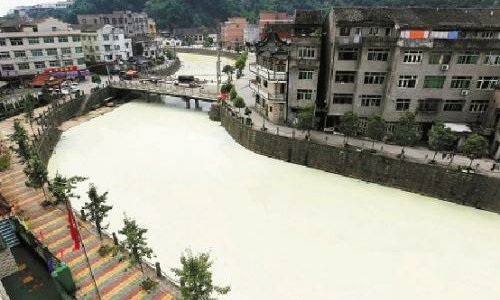
Since April 1, 2013, media reports have said that pollution caused the water in a 25-km-long waterway located in Dongchuan District of the provincial capital Kunming to turn milky white.
Photos supporting the media claims triggered public anger.
● Reason:
Three ore dressing or mining companies in Dongchuan District were found to have placed hidden pipes to discharge waste water into the waterway directly from 2010 to March 2013.
● Impact:
The major pollutant was toxic xanthogenate. Discharging the wastewater, which contained toxic substances and suspended solids, will pollute the water and soil.
A local official said the waterway was not a source for drinking water, but for farmland irrigation.
● Latest update:
7 sentenced over SW China river pollution
Seven people were sentenced on November 18 in Southwest China's Yunnan Province after they were convicted of polluting a local waterway, which was mocked as "milk river" in April, a court confirmed.
Eight people, including the legal representatives and major managers of three ore dressing or mining companies, were convicted of polluting the environment in a court in Xundian County, according to the Intermediate People's Court of Kunming City, capital of Yunnan Province.
8 arrested over SW China river pollution
● Reactions:
Local authorities:
SW China official apologizes over polluted river
Lin Hua, deputy chief of Dongchuan District of the provincial capital of Kunming, said April 11 she apologized on behalf of the district government for failing to prevent such pollution after a local polluted waterway was mocked as "milk river." The district government requested 28 of the total 45 plants along the waterway to suspend operation for rectification.
The hidden pipes placed by three ore dressing plants were removed on April 3 and 4, and the plants have been asked to suspend production to make corrective measures.
● Location:
Weifang, Shandong Province
● Time:
February, 11, 2013
● Incident:
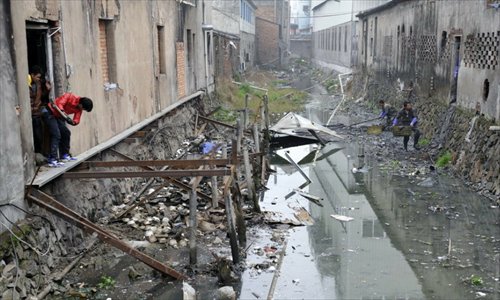
The posts, forwarded by Deng Fei on February 14, a reporter with Phoenix Weekly, quickly went viral, sparking concerns that China's underground water might have been polluted by unscrupulous enterprises.
The alleged culprits include chemical plants, alcohol producers and paper mills.
● Latest update:
Groundwater polluters pay 6m in fines
Some 6.13 million yuan ($999,870) of fines were issued to 88 companies for violations resulting in underground water pollution in a 40-day campaign in North China, the Ministry of Environmental Protection said May 9, 2013.
The ministry said that 2012, underground water in 57 percent of monitoring sites across China was polluted or extremely polluted. In addition, 298 million rural residents do not have access to safe drinking water.
● Reactions:
Local authorities:
Reward offered for tips on underground water pollution
The government of Weifang City offered a 100,000 yuan ($15,873) reward to the first whistleblower who can help prove the widely circulated rumors on February 17.
The government of Weifang said it has sent more than 600 law enforcement officers to conduct investigations among 715 local enterprises, but they have found no evidence to support Internet users' allegations.
The department said it would soon kick off a campaign in the province to crack down on illegal underground emissions.
| In 2012 |
Toxic chemicals leaked to Zhuozhang River in Changzhi
● Location:
Changzhi, Shanxi Province
● Time:
December 31, 2012
● Incident:
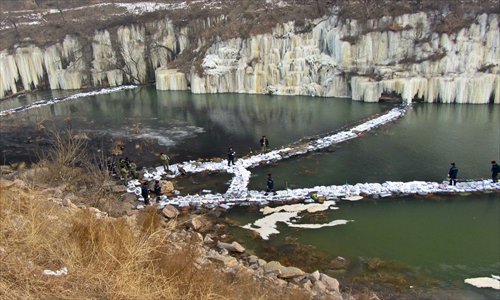
On December 31, 2012 about 9 tonnes of aniline was leaked by a chemical plant owned by the Tianji Coal Chemical Industry Group into the Zhuozhang River in Changzhi City, Shanxi.
The provincial authority did not receive the pollution report from Changzhi until five days after 9 tons of aniline was leaked into the Zhuozhang River by a local chemical plant.
● What is aniline?
Aniline is a toxic chemical widely used to manufacture pigments, herbicides and other chemicals.
● Reason:
An initial investigation revealed that a loose drainage valve was to blame for the leak.
An initial investigation revealed that 8.7 tons of aniline was leaked from a broken pipe owned by the Tianji Coal Chemical Industry Group. The leak was discovered on December 31, 2012 by a plant employee during a routine check, by which time the aniline has already found its way into the nearby Zhuozhang River through a loose drainage valve in the plant.
● Impact:
The contamination has affected drinking water supplies in downstream Handan in neighboring Hebei Province, which has a population of more than 1 million people.
The aniline concentration level at Wangjiazhuang water monitoring station on the border of Shanxi and Hebei provinces reached 720 times safe levels before January 5 and dropped to 34 times safe levels by 2 am January 6 morning. The national standard only allows less than 0.1 milligram per liter of the substance in potable water.
● Latest update:
Four sacked for toxic leakage
Four people directly responsible for 8.7 tons of toxic chemicals leakage into a river in North China's Shanxi Province have been dismissed, local authorities said January 6.
Chen Jianwen, Tianji Coal Chemical Industry Group general manager, Ren Yongjie, the group's deputy manager who is in charge of work safety, and two heads of the plant's storage workshop were sacked.
Making pollution public
● Reactions:
Local authorities:
Changzhi, Shanxi Province
Mayor sorry for delay in dealing with chemical spill
Changzhi's Mayor Zhang Bao apologized for the affair at a press conference on January 7. He said the municipal government had underestimated the severity of the chemical leak after receiving the polluter's report on the accident.
Handan, Hebei Province:
Handan in Hebei Province located on the river's lower reaches, has cut the water supply from the Zhuozhang River and switch to underground water in case the river was contaminated.
Anyang, Henan Province
New Henan dam to counter chemical spill
Workers in a central China City are building a new dam to protect a reservoir from contamination by a recent chemical leak, the municipal government revealed on January 7, 2013.
Residents:
The delayed response of the contamination caused panic in Handan, where residents ransacked stores for bottled water.
● Voices & Commentary:
Key insurance products grows slowly
| In 2011 |
1. Polluted water in Chachong Reservoir in Qujing
● Location:
Qujing, Yunnan Province
● Time:
April to June, 2011
● Incident:
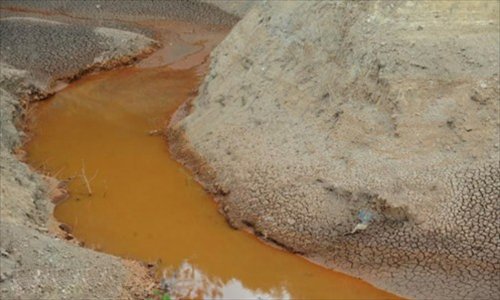
● Impact:
No human deaths have been attributed to the chromium pollution, but at least 14 local residents have been diagnosed with cancer since 2002 and many suspect their diseases were caused by contaminated drinking water. Over 3,000 local residents are currently living near the company's dump sites.
Polluted water in the Chachong Reservoir has been blamed for the deaths of 77 livestock.
● Latest update:
Pollution scandal brings halt to projects
The country's environmental watchdog will suspend reviews of all new industrial projects in Qujing, Southwest China's Yunnan province, until the city cleans up its toxic chromium slag and remedies polluted soils, a senior official said on September 1, 2011.
Enterprises involved in the production of chromium and polycrystalline silicon, and in the disposal of sewage sludge and electronic waste will be placed under special scrutiny.
Five detained over toxic waste dumping in SW China
Five suspects have been detained over a Chinese chemical company's dumping of carcinogenic industrial chemicals that could threaten the water sources for tens of millions of people, police in the southwestern Yunnan Province said August 23.
● Reactions:
Ministry of Environmental Protection:
Environment ministry investigates toxic waste dumping in SW China
China's top environment agency has sent investigators to probe a chemical company's dumping of carcinogenic industrial chemicals into a reservoir that feeds one of the country's largest rivers.
Local authorities:
Qujing, Yunnan Province
Local govt to probe toxic waste dumping in SW China
The Qujing city government will investigate to determine if watchdog officials could be guilty of dereliction of duty, and if any are identified as so, they will be handed over to judicial authorities, the city's information office said in a statement.
The city government also has ordered a thorough check on the distribution of all dangerous materials amid efforts to prevent similar pollution threats.
Water safety unaffected after industrial waste dumping: local environment authorities
Guangdong Province:
Authorities deny south China river pollution rumor
Environmental protection authorities in south China's Guangdong Province said on April 13, 2011 that no chromium pollution has been detected in a major river that flows through the province, responding to an online claim that the river's headwaters were polluted.
● Location:
Jiande, Zhejiang Province
● Time:
June 4, 2011
● Incident:
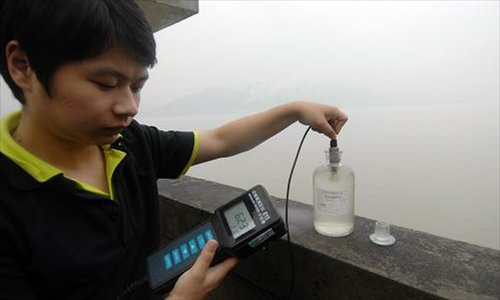
Phenol leak pollutes river in east China
A tanker traveling along a highway rolled and leaked toxic chemical phenol into the Xin'an River in east China's Zhejiang Province June 4 night.
Xin'an River, which feeds into the Fuchun and Qiantang rivers, is the source of drinking water for several cities in Zhejiang, including the capital city of Hangzhou.
● What is phenol :
Phenol and its vapors are corrosive to the eyes, skin and respiratory system. Skin contact with the substance may cause burns. It can also harm the central nervous system, heart, lung and kidney.
● Reactions:
Local authorities:
Water safe as pollution drops in east China chemical spill
The water sources for five water utility companies that were shut down in wake of a chemical spill into a river in east China's Zhejiang Province are safe again, the provincial environmental protection bureau said June 6.
The bureau also ordered close monitoring of water quality that could prompt shut-down of water plants again in case pollution increased at their water-taking points.
Following the chemical spill, the Xin'an River dam has increased water discharge to dilute the pollution levels.
Resident:
Although supplies of drinking water in downtown Hangzhou have not been contaminated, some citizens have rushed to purchase bottled water, causing some supermarkets in the city to run out of bottled water.
| In 2010 |
1. Oil spill in the Yellow Sea after pipelines explode
● Time:
July 16, 2010
● Location:
Dalian, Liaoning Province
● Incident:

Oil spill at sea after pipelines explode
On July 16, a pipeline explosion in Dalian, a port city in Northeast China's Liaoning Province, created a massive oil spill in the Yellow Sea. It had contaminated at least 50 square kilometers of ocean waters.
The amount of crude oil that had spilled into the sea was estimated at 1,500 tons.
An oil pipeline measuring nearly a meter in diameter exploded at 6 pm July 16 near Dalian's Xingang Harbor, triggering an adjacent smaller pipeline to explode too. At least five subsequent explosions fueled the fire at the smaller pipeline.
● Photos:
Dalian oil spill cleanup continues
● Reason:
The explosions happened after a 300,000-ton Liberian oil tanker discharged its load at the harbor. The tanker left the harbor safely. Both pipelines that exploded were owned by the China National Petroleum Corp (CNPC).
● Impact:
Yellow Sea under threat from Dalian oil spill
According to the Dalian Maritime Safety Bureau, a dark brown belt of crude oil and other pollutants stretched at least 50 square kilometers across seawaters off Xingang Harbor, with 10 square kilometers of sea seriously polluted and 100 square kilometers affected.
No casualties were reported. No residents live within three kilometers and the nearest community, with about 600 people, is four kilometers away, according to a local government spokesperson.
The burning of crude oil may produce more than 40 kinds of pollutants, which, however, are not considered seriously harmful to people's health.
● Latest update:
Dalian vice mayor declares cleanup of oil spill is completed
Most of the 1,500 tons of crude oil that spilled into waters off Dalian in Liaoning Province have been cleaned up, officials said July 26 at a news conference. However, some local workers reported that the water remains murky in some areas.
● Reactions:
Local authorities:
Liaoning firefighting authority mobilized 2,000 firemen in 14 cities of the province to join the cleanup operation at sea.
More than 8,000 people were mobilized along with special vessels using dispersants, absorbents and oil-eating bacteria to clean up the oil spill.
Dalian Ocean and Fisheries Bureau asked experts to monitor the situation after the incident and aquatic products and foodstuff were not affected.
Investigators looking into oil pipeline explosions in NE China port city
China races to prevent oil slick spreading to open sea
China National Petroleum Corp. (CNPC):
CNPC vows to reduce impact of crude oil pipeline blast in Dalian
2. Acidic copper wastewater leaked into the Tingjiang River in Shanghang
● Time:
July 3, 2010
● Location:
Shanghang county, Fujian Province
● Incident:

The country's largest gold producer Zijin Mining Co. was blamed for a wastewater leak that has contaminated a major river in eastern Fujian Province.
On July 3, nearly 9,100 cubic meters of waste water leaked from the sewage tank flowed through an "illegally built passage" into the Tingjiang River between 4 pm July 3 and 2:30 pm July 4.
● Pollutant:
Acidic copper wastewater
● Impact:
Nearly 2 million kilograms of fish in a reservoir on the Tingjiang river have been killed or poisoned; and smell of dead fish is noticeable 10 kilometers from the reservoir.
● Reason:
An initial investigation attributed damage to the contaminant pool's leakage-protection membrane.
● Latest update:
China's Zijin fined 9.56 mln yuan for water contamination
China's leading gold producer Zijin Mining Co., said October 7 it had received punishment decisions from Fujian provincial authorities, including a fine of 9.56 million yuan (about $1.43 million) for severe water pollution caused by its subsidiary copper plant.
Copper factory executives detained, county official resigns after water contamination
Three managing personnel of a copper plant have been detained and a county official has resigned after the plant contaminated a local river in Shanghang County, east China's Fujian Province.
● Reactions:
Local authorities:
The local government in Shanghang county, Fujian Province, paid farmers for all the fish that died or were poisoned.
The local government purchased the dead fish at a price of 12 yuan ($1.8) a kilogram from local fish farmers for decontamination treatment to avoid further pollution.
● Zijin Mining Group:
China copper factory caps new waste leak after river pollution scandal
A Chinese copper plant at the center of a river pollution scandal reported a new leak July 16, but it capped the leak quickly and avoided exacerbating damage already done to a river, company sources said.
The Hong Kong-listed Zijin Mining Group suspended its stock trading July 12 but shied away from an apology and was absent at a press conference where local authorities in Shanghang county briefed reporters on damage-control efforts.
● Residents:
No human illnesses or deaths caused by the contamination have been reported, but the public has moved quickly to take precautions.
● More News:
Mining leak pollutes river
Govt pays farmers for contaminated fish
Zijin mining plugs new leak
Chinese gold miners fined for toxic spill